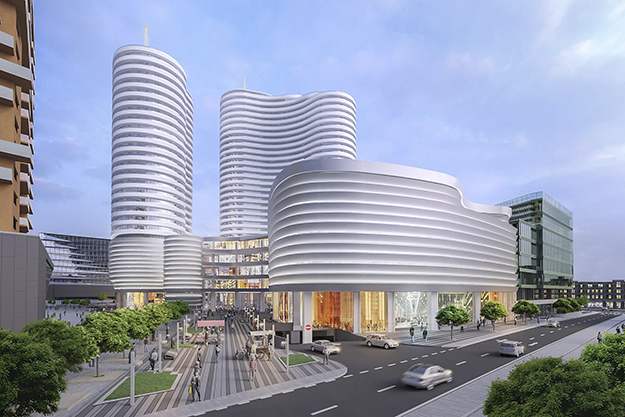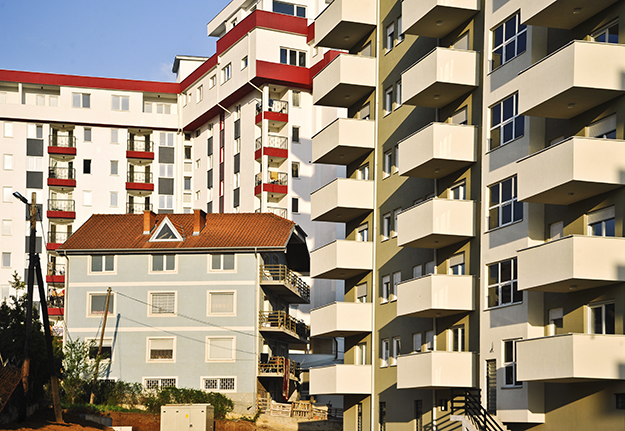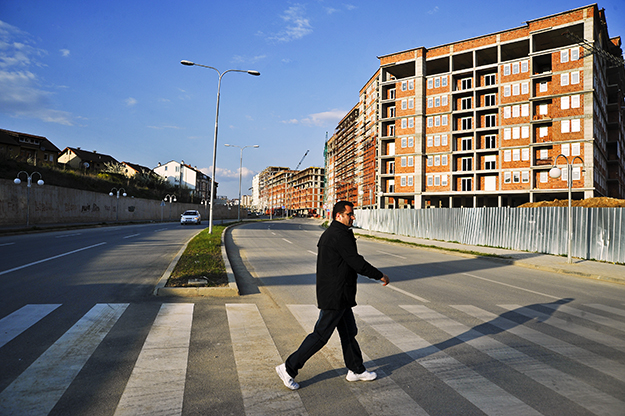Strolling down the streets of Bregu i Diellit (Sunny Hill) toward the center of Prishtina, one inevitably passes a series of major construction works. Large apartment blocks popping up like mushrooms are seemingly found at every intersection, and they will soon successfully hide skeletal remains of previous attempts at construction, or the ruins of homes left empty for the past 20 years.
“The Residence of the Queen,” “Golden Park,” “VIP Tower” and the “Green Apartments” (the latter brought to you by “Pika Luxury”) are some of the titles carried by these rising monoliths, promising the high life for those with the means to purchase it.
Meanwhile, downtown raises the promises of a new business zone, in the shape of a circular, Dubai-esque glass-covered “Pristina City Center” in the Lakrishtë neighborhood, the premises of an investment company combining a large shopping center with “extraordinary capacity,” luxurious apartments with “the highest floors in the Balcans” (sic) and a “well-thought space to suit every requirement of the business administration,” complete with “commercial units, high standards and underground parking.”

New luxury buildings such as the planned “Prishtina City Center” complex seem all the rage in Prishtina, but affordable housing remains sorely lacking. Photo: Prishtina City Center promotional material.
While “Pristina City Center” might be the shining promise of a future invigorated economy, the ultramodern interior designs of its apartments (no price given) stand in stark contrast to Kosovo’s average net wage of 471 euros. And it also reflects an overall trend in Prishtina: A boom in high-end housing and a stagnation in the supply of affordable living space.
Construction is an important industry in Kosovo. According to Open Business, a platform developed by Open Data Kosovo, in 2018 the construction industry ranked as the second largest industry, involving two of the largest firms in Kosovo.
Meanwhile, Kosovo does not seem to have a lack of existing available housing — according to data gathered in 2011 as part of the last census, 15,402 dwellings in Prishtina stood empty at the time. But given that Prishtina’s population is a little over 200,000 (2014) and its approximately 40,000 regularly inhabited dwellings, the numbers indicate that a few years ago each dwelling was occupied by about five people on average.
Of course, since the available data was gathered, the variables have shifted. Many more buildings have been constructed, but the population has also swelled — according to data from the Kosovo Agency of Statistics, around a thousand people migrate into Prishtina each year.
Housing insecurity in Prishtina
Agron Beka is the executive director of the Social Housing and Property Rights in Kosovo (SHPRK) NGO and a former legal advisor to the minister of spatial planning. When asked whether Prishtina is ready to receive an influx of a thousand new inhabitants per year, he gives a straightforward answer: “No. Prishtina is not ready at all to accept all these people.”
Despite empty houses and newly constructed apartment blocks, he says that there is a lack of affordable housing — most of the available housing is simply too expensive for the average individual searching for a place to live in the city.
Genc Bashota, director of strategic planning and sustainable development at the Municipality of Prishtina, agrees that there is not enough affordable housing for the steady flow of newcomers, and acknowledges the need to build more. He notes that this was one of Mayor Shpend Ahmeti’s promises in his election campaign.
For many young people from Prishtina, remaining living at home with their families is the most financially viable option.
According to Bashota, the average rent price for a single-room apartment in Prishtina ranges from 250 euros to 350 euros per month in more sought-after neighborhoods, and from 200 euros to 250 euros in the least popular, thereby excluding a large segment of the population.
For many young people from Prishtina, whether students or professionals in their mid-20s or 30s, remaining living at home with their families is the most financially viable option; those who don’t, typically share an apartment with other people.
Diana Morina moved to the capital from Gjilan five years ago to study, and currently works in the NGO sector. She has moved more than five times during this period, and describes having had to move in with strangers who would later reveal themselves as uncomfortable to live with, or who would have to leave the apartment at short notice, leaving her unable to pay rent.
Describing her experience looking for housing, Morina says that “for a long time, finding a good, affordable apartment has been a much bigger issue for me than finding a job or dealing with my studies.”
Students are easy targets, she says. Owners use their precarious position to only rent them apartments in bad conditions and at a hefty price, hoping that their lack of alternatives leads them to accept. Furthermore, in her experience, owners prefer not to rent through an agency in order to try to avoid rental contracts.
“The economic status impacts a lot of your decisions as a young person living in the capital city.”
Diana Morina, young professional
She even recalls a previous landlord breaking into her apartment while she was still living there: “What a pleasant experience to find someone drinking your coffee from your cup, in the apartment that you are paying for!” she says.
Morina currently lives with three other people in a two-bedroom apartment. She estimates that she spends about 20 percent of her income on rent and utilities, which is a little less than the average household. However, she frequently travels back to her home city, as do her flatmates — and while it is a good quality apartment in a new building, the small space means that two people have to share a room, leaving little privacy.
Being forced to live in cramped conditions comes despite all flatmates being relatively well-paid professionals.
“Most of the people I know that come from other cities face pretty much the same challenges,” Morina says. “The economic status impacts a lot of your decisions as a young person living in the capital city. Many people share apartments with someone else or some are lucky enough to find a decent, affordable one-room apartment to live in on their own.”
She recalls that it was even more difficult during her time as a student, since landlords assume them to be irresponsible and liable to damage the place. “There were many cases where my friends and I found the ‘perfect’ apartment but the moment they realized that we were students, even though we were also working, this would become a great issue and we were not given the chance to rent the apartment,” Morina remembers.
Meanwhile, Morina is a working professional, earning an above-average salary — many are in much worse situations.
The hollow construction boom
While Morina is cramped into her apartment with three other people, the freshly arisen monoliths stand, for the most part, unoccupied.
Prishtina is a highly attractive ground for investors, Beka explains. While it costs the same for investors to build in Prishtina as in Mitrovica or in Fushë Kosovë, which lies about seven minutes away, he says that “when they sell, in Prishtina, it’s almost double. That’s why it’s attractive for investors to build in Prishtina. ‘No matter where. Just, let me build in Prishtina.’”
He is of the opinion that the diaspora, particularly the new generation, which has grown up in Switzerland or Sweden and are now often earning quite well, is part of the reason that many apartments stand empty for most of the year.
“Now the new generation comes; they’re not used to living in villages or somewhere else, so what they do is they buy an apartment in Prishtina, they sit here for one month, let’s say, and within this one month they go twice or three times to the village where their father used to live, and then they come here because the nightlife here is very attractive, and that’s why this apartment is used for one month and for 11 months it’s closed down,” Beka suggests.

Kosovo’s capital is undergoing a construction boom, but many of the new apartments remain largely unoccupied. Photo: Atdhe Mulla / K2.0.
Another reason is that investors are not in a rush to fill these apartment blocks, since “those who build in Prishtina, they have enough capital, they have enough money to leave it there, and leave it there until 2030. And if they succeed to sell it in 2030, they still have a profit from that,” Beka holds.
“I don’t know why we need more apartments, why we need more buildings, you can see that every day we have less and less green spaces and this is just due to those buildings that are coming up around Prishtina,” he laments. “So in one sentence, I hope that this trend is going to be stopped, I don’t see that Prishtina needs all those apartments, and the end of these buildings will come when Kosovo has a very good economic development plan for Prishtina and other cities.”
“We can not interfere with the market demand for luxury housing in Prishtina.”
Genc Bashota, Municipality of Prishtina
Regulation of the construction industry has been a significant issue in the past, the post-war construction boom having resulted in much unregulated, or illegal, construction projects. This was partly a result of money laundering but also simply due to a lack of spatial planning, according to the Kosovo Chamber of Commerce.
In 2014, after Shpend Ahmeti was sworn in as mayor of Prishtina for the first time, the Municipality began to implement the Law on Legalizing Constructions, which led to a large number of buildings being regularized post-facto, and another great number of illegal constructions begin demolished — in particular those representing safety threats.
Bashota, from the Municipality, explains that while there are now several plans regulating the construction industry, there is no specific plan to achieve a balance between luxury housing and affordable housing: “We can not interfere with the market demand for luxury housing in Prishtina,” he explains.
The need for affordable housing
What is to be done if the market fails to provide affordable housing? What is being done to provide social housing for those in need?
The 2010 Law on Housing Financing Specific Programs, besides establishing a structure for the distribution of existing and construction of new social housing, also empowers municipalities to seize privately owned vacant housing and rent it to people who qualify for social housing, while subsidizing 50 percent of the rent.
Beka claims that while the law provides for this possibility, it has almost never taken place in reality, due to procedures being vague and officials worrying about opening the doors for corruption.
While he understands their reservations, he laments the lack of initiative. “I’d be very happy to see this happen somewhere, in order, if nothing else, to test it out, to make a pilot project,” he says, arguing that performing such a test would enable the government to identify the weaknesses and benefits of such a system.
Bashota, from the Municipality, says that he “can confirm that we are working on drafting the Masterplan for affordable housing.” He insists that “it is important for the Municipality to build affordable housing,” and says he can confirm that 700 units of social housing are currently under construction.
“You have people in need, but [according to the] requirements that they put in the law, they do not qualify.”
Agron Beka, SHPRK
According to Beka, however, this is not enough, but at the same time, nor will they all be filled by people in need due to deficiencies in the current law.
“With the legal basis that we had [introduced] in 2010, you cannot find 700 people — because they do not qualify,” Beka claims. “So, you have people in need, but [according to the] requirements that they put in the law, they do not qualify.”
He recalls that during a previous attempt to fill 50 units, the Municipality experienced great difficulties finding people who would legally qualify for the social housing program.
However, this does not mean that there are no people in need. In his view, one of the biggest problems with the current system is the way in which it is evaluated if an individual, or household, qualifies for social housing.
Beka explains that, according to the current system — which involves a complex formula for calculating eligibility — individuals earning above certain variable income thresholds do not qualify for social housing; but if one earns below the thresholds, they can keep the social housing indefinitely.
While this seems positive on the surface, it has unintended negative effects. On the one hand, there are people who genuinely suffer from housing insecurity who do not qualify for social housing because they earn too much according to the current formula, while on the other hand, people who do qualify can become trapped in a cycle of poverty.
“So basically what you are doing, is that you are giving them an apartment and you are telling them, ‘This is it for your life,’ and from now on, there’s nothing you have to do, you just sit there and remain poor for your life,” he says, arguing that many of those who receive social housing are effectively incentivized to avoid the pursuit of a better career, since they would risk the loss of their homes.
Furthermore, this means that any additional income tends to be made informally, with no paperwork and no taxes.
Das Wiener Modell
Beka has some ideas about how to approach the issue. A central part of what his NGO, SHPRK, does is to research and develop policy regarding social housing, and while he was involved in the process of drafting the 2010 law, he doesn’t hold the current social housing system in high esteem.
Instead, he proposes to look outward for inspiration, rather than relying on tradition.
“There are plenty of projects around the world so that we don’t need to invent much, we just need to copy and paste into Kosovo, without any doubt we are going to be successful,” he maintains. “Whatever we do is going to be better than what we have.”
Beka’s ideal would look a lot like the Austrian model of affordable housing. In Vienna, he says, the majority of the population lives in state-subsidized, affordable housing. Naturally, this does not mean that all those people are poor, but that the philosophy surrounding housing is entirely different.
“So for example, the samples that they gave us in Vienna — it’s not the downtown of Vienna but somewhere nearby — it was one euro per one square meter, which means that [if] you have 50 square meters you are going to pay 50 euros, which is nothing again, but we need this money in order to maintain this building,” Beka recalls.
Limited Profit Housing Associations (LPHAs) in Austria comprise housing co-operatives, as well as private-limited and public-limited companies, operating under regulations mandating the majority of their profit to be reinvested into new construction or refurbishment of existing housing.
Limited Profit Housing Associations hold 23 percent of the total market stock of housing in Austria.
Rent ceilings are set by subsidy authorities of the government and, according to a study by the Australian Housing and Urban Research Institute, do “not exceed the level necessary for management and construction, together with a return to undertake future projects.”
It is not a highly profitable industry. In Beka’s own words, “this is a penny business, in which, as an LPHA, you are not entitled to gut the money and buy a car, all you can do is have a safe fund in order to build a new house for others.”
However, he says that the companies are well respected in Austria and that it has proved to be a successful business model.
Indeed, according to the Austrian Institute for Real Estate Construction and Housing Ltd., LPHAs hold 23 percent of the total market stock of housing in Austria and produce more than half of the country’s annual multi-apartment housing construction — outperforming both municipal housing and private multi-apartment housing construction.
All this is achieved through state subsidies, but at a cost of 0.9 percent of annual GDP, well below many EU countries. Furthermore, the important market share of LPHAs means that the sector has an important influence on the overall housing market, stabilizing it and keeping prices low.
This is only one example. Beka also sees inspiration in the Romanian model, which aims to save their communities, and younger populations specifically, from fleeing Romania for better opportunities. “They are giving very low interest loans, for 30 years or something like that, which for a couple that is working is nothing, because they will be equipped with an apartment,” he says.
He sees a lot of reasons to specifically invest in the future of young couples, highlighting that they often find themselves stuck. “You have a couple who are working, both of them are working, but they cannot afford to buy a new apartment,” he says.

Despite positive examples from around Europe, Kosovo does not seem to have any big plans to overhaul its approach to producing affordable housing. Photo: Atdhe Mulla / K2.0.
Oftentimes, he says that “they have to live with their parents, because the state doesn’t give new ideas, opportunities for them to think about their own families.”
Meanwhile, a new draft law is currently being drawn up in Kosovo to replace the 2010 law and Beka and SHPRK have been actively involved in its drafting.
While he says that many of his organization’s recommendations have been accepted, he believes that the new law is still tinkering around the edges, and doesn’t represent a wholesale re-think of the way in which affordable housing is addressed in Kosovo. “We know that, more or less, this is a law that is going to be with some small differences, because we didn’t make many changes,” he says.
In any case, the law is currently stuck in limbo due to sparring between the Ministry of Finance and the Ministry of Environment and Spatial Planning.
Only time will tell what the future holds but, despite all the building, a housing revolution certainly does not seem imminent.K
Feature image: Atdhe Mulla / K2.0.




